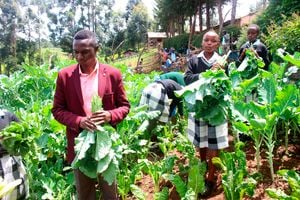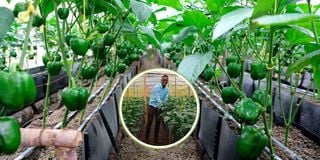
Willand Charawe at his Capsicum greenhouse in Rongai on May 22, 2024.
Some children dream of becoming engineers when they grow up, while others aspire to be film stars, doctors, or air hostesses.
All Willand Charawe wanted to be was a farmer. Now, at the age of 24, his childhood dream has become a reality.
In just four years, he has swiftly progressed from his first greenhouse to seven others, establishing himself as a successful hydroponic farmer. [A technique of growing plants using a water-based nutrient solution rather than soil].
The success of the young man who lives by the motto "dreams only work if you do them," has sprouted from an eighth of an acre in Ongata Rongai.
Charawe says his love for farming started young.
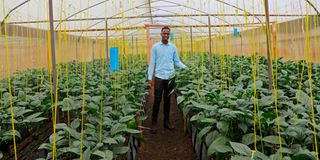
Willand Charawe at his Capsicum greenhouse in Rongai on May 22, 2024.
In his teenage years, Charawe would work for local farmers after school and on weekends, learning valuable skills such as selecting the right seeds for crops, using the correct fertiliser, operating farm machinery, and preparing fields for cultivation.
He also had a garden at his parent's home where he had grown passion fruits, tomatoes, and strawberries, and was looking for ways to transform the city land into a money-spinner.
"I knew I wanted to farm when I was very young. I just didn't know how to do it," Mr Charawe told BDLife during the interview at his farm.
His journey to becoming a successful hydroponic farmer began in 2018 when he enrolled at Miramar International College to study agriculture.
Additionally, he enrolled at Chuka University to pursue a Bachelor of Science in Agricultural Education and Extension (AGED), which teaches courses in agricultural extension, agronomy, soil science, animal science, and agricultural economics.
While still in school, he set up a greenhouse to grow capsicum, also known as bell pepper, using the hydroponic method.
He later travelled to Israel, courtesy of an NGO, where he learnt how to improve his hydroponic farming skills.
Despite his busy schedule as a student, he has successfully managed his greenhouse where he grows capsicum hydroponically.
Why hydroponics?
Farming can be done in many ways, but Mr Charawe has chosen hydroponic technology. This is a technology that skips the soil and uses another material to support the plant's roots, and grows crops directly in nutrient-rich water.
"I wanted to challenge myself by trying something that a lot of people don't know about. Hydroponics is simply controlled agriculture.
When I tell people that I grow my produce using hydroponics, I usually get something close to this response: "Sounds cool...sounds like it has something to do with healthy food maybe? Must be genetically modified?" says Mr Charawe.
"You can do this type of farming with your suit on because you don't come into contact with the mud," he adds.
During the interview, he was in official attire.
"Hydroponics also allows growers to produce food anywhere, at any time of the year, and to achieve higher yields with fewer resources," he adds.
In his eight-metre by 24 metres ventilated greenhouse in Rongai, Kajiado County, he has grown up to 1,200 capsicum plants through a media-based trough system.
The system uses a type of containerised media to grow the plants. This media is primarily used to anchor the plants, while the nutrient solution is delivered to the plants via sub-irrigation or top irrigation.
"Even though you don't need soil, the roots of the plant still need something to hold on to," he explains.
"I use BA SF technology to recycle tomato and cabbage waste, which is fed to warmers. The final waste is then mixed with pumice," says Mr Charawe.
"Pumice is a great soil amendment to use in your garden for moisture regulation and aeration. It is a mined, igneous, volcanic rock product," he adds.
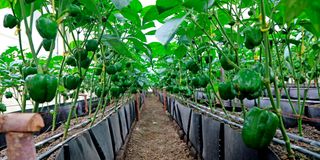
Capsicum at Willand Charawe's greenhouse in Rongai in this picture taken on May 22, 2024.
This is the medium he uses to plant the capsicum. It has a high nitrogen content, which is a basic nutrient for the capsicum.
Mr Charawe points out that hydroponic systems require less water than traditional soil-based systems.
"This is because closed systems are not subject to the same evaporation rates. Also, the water used in hydroponic systems can be filtered, replenished with nutrients, and returned to the plants, so water is constantly being recycled rather than wasted," he says.
He waters his plants once a day through a drip line, depending on the temperature.
"If it is extremely hot, I water twice, in the morning and the evening. In a day I can use 10,000 litres of water and save up to 700 litres that go back into the tank," he says.
To further reduce production costs, he has invested in solar power to pump water for irrigation.
Besides capsicum, hydroponic systems are increasingly being utilised to cultivate other fruit crops such as tomatoes, cucumbers, strawberries, and melons.
Leafy vegetables are more commonly grown in different hydroponic systems, although the nutrient film technique (NFT) is often employed for lettuce and herbs.
NFT is a hydroponic technique in which a very shallow stream of water containing all the dissolved nutrients required for plant growth is recirculated past the bare roots of the plants in a watertight channel.
The Sh500,000 venture is the culmination of hard work and passion that is now giving him what he says is a good return.
There are three types of capsicum, with the primary colour being green, when they mature, they turn red or yellow type.
"This is because the red and yellow ones cost more than the green ones," he explains.
"The green ones are sold at Sh60 per kilogramme, while the red and yellow ones go for Sh150 per kilogramme. When there is an abundance, the red and yellow ones go for Sh100."
The fruit ripens in four months. A plant gives half a kilogramme in one harvest, and the harvest is done every week. However, the weight decreases as the months go by. After four months, a new seedling is planted.
"The first harvest can give 400 kg, then it stabilises at 200 kg, then at 60 kg in the sixth month. At that point you uproot the plant and start again," says Mr Charawe.
"I earn up to Sh300,000 a month from one greenhouse. I harvest for six months in a row," he says.
He has his supplier who takes up to 300 kilos, which he then distributes. He sells to him at a small discount. But generally, he sells for between Sh150 and Sh200 per kilo.
Mr Charawe has another seven greenhouses coming up, which he estimates will give him up to two tonnes of the fruits.
Is he making a profit? the BDLife asked again to confirm his first words.
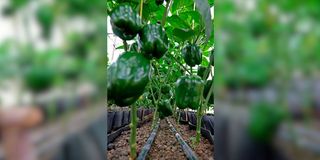
Capsicum at Willand Charawe's greenhouse in Rongai in this picture taken on May 22, 2024.
"That's why we are building many more," he replies with a sarcastic laugh. "The capital is high and the investment is high."
To get good returns, Mr Charawe advises to grow on a large scale or to grow all varieties.
But he faces a bigger challenge.
"It's difficult to explain to consumers that we don't use artificial chemical sprays. Many believe that greenhouse food is sprayed with lots of chemicals and is not organic," he says.
Growing hydroponically in greenhouses helps the farmer deal with diseases and is also easier to monitor because it is enclosed.
For pest control, he uses sticky traps that attract insects such as white flies, and also helps him to know what kind of spray to use.
"We don't concentrate on [synthetic] pesticides. We use pesticides from neem trees," he says.
Mr Charawe has made hydroponic farming look so simple, but he makes one thing clear.
"It requires a bit of science. Every plant grown hydroponically needs a different electrical conductivity feed," he says.
Electrical conductivity feed is the level or amount of fertiliser the crop should use.
He says that sometimes farmers tend to use too much, which results in the plants burning up less fertiliser.
"For our plants, at the beginning, at one week, we feed them with an electrical conductivity feed of 600. At one month, we feed with 1,200 to 1,800 of electrical conductivity, and 1,600 to 1,900 when at 2.5 to three months," he explains.
This enables them to get all the nutrients they need. The technology, he says, helps him to know what the plant is lacking.
Now that his dream of being a farmer has come true, Mr Charawe has a new dream.
"I want to have a farm that produces almost all crops, starting with capsicum, strawberries and tomatoes, and prove that hydroponic farming can be done organically," he says.

